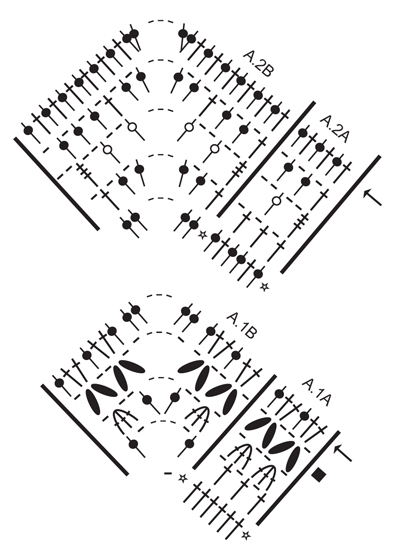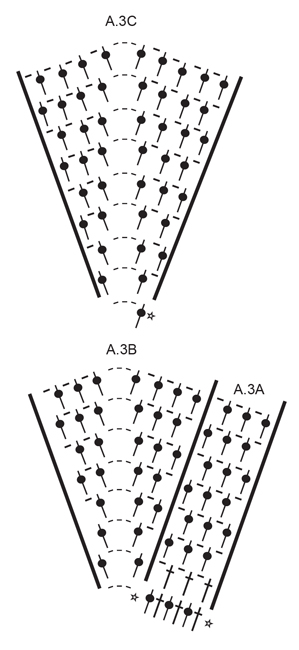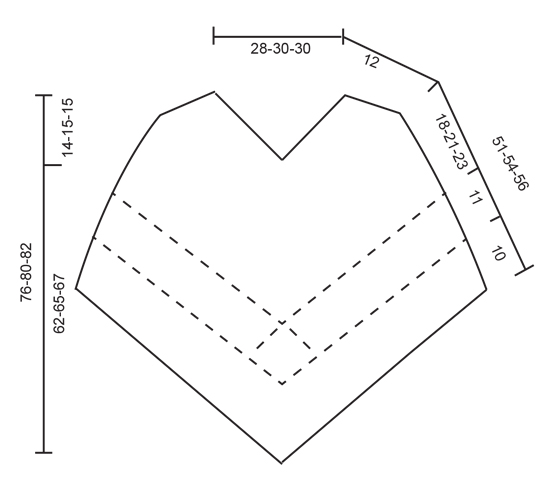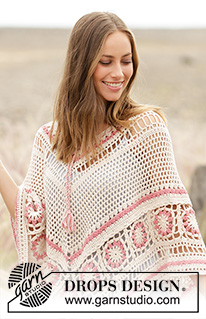A Wistful Dream |
||||||||||||||||||||||||||||||||||||||||||||||||||||
 |
 |
|||||||||||||||||||||||||||||||||||||||||||||||||||
Poncho with lace pattern and crochet squares, worked top down in DROPS Belle. Sizes S - XXXL.
DROPS 176-16 |
||||||||||||||||||||||||||||||||||||||||||||||||||||
|
PATTERN: See diagrams A.1 to A.6. CROCHET INFO-1: The first treble crochet from the beginning of the round is replaced by 3 chain stitches and the round finishes with 1 slip stitch in the 3rd chain stitch at the start of the round. CROCHET INFO-2 (diagram): Each round starts with 3 chain stitches and finishes with 1 slip stitch in the 3rd chain stitch at the start of the round. COLOURS: The whole poncho is worked with light beige apart from the 3 rounds marked with a black square in the diagrams, these rounds are worked with old pink. The square is worked with light beige apart from the 4th round (= the round with together-worked treble crochets), this round is worked with old pink. INCREASE TIP-1: Increase 1 treble crochet by working 2 treble crochets in/around the same stitch. INCREASE TIP-2: Increase 1 treble crochet + 1 chain stitch by working 1 treble crochet, 1 chain stitch, 1 treble crochet and 1 chain stitch around the same chain stitch. ---------------------------------------------------------- PONCHO: The poncho is worked in the round and top down in 3 sections which are worked together as you go. Start with the first section, then work the squares separately as section 2. Increase mid front and mid back as shown in the diagram and otherwise increase evenly along the sides. FIRST SECTION: The round starts on the left shoulder. Work 146-178-206 chain stitches with hook size 4 mm and light beige and form them to a ring with 1 slip stitch in the first chain stitch. Work 3 chain stitches – READ CROCHET INFO-1, then work 1 treble crochet in each of the next 5-3-5 chain stitches, * skip 1 chain stitch, work 1 treble crochet in each of the next 4 chain stitches *, repeat from *-* 5-7-8 more times (= 30-36-42 treble crochets), 1 chain stitch (= chain space in front), work 1 treble crochet in each of the next 4-4-4 chain stitches, * skip 1 chain stitch, work 1 treble crochet in each of the next 4 chain stitches *, repeat from *-* 13-16-19 more times (= 60-72-84 treble crochets along the side), 1 chain stitch (= chain space in the middle in the back), work 1 treble crochet in each of the next 6-4-6 chain stitches, * skip 1 chain stitch, work 1 treble crochet in each of the next 4 chain stitches *, repeat from *-* 5-7-8 more times (= 30-36-42 treble crochets along half the side) = in total 120-144-168 treble crochets and 2 chain stitches on the round. REMEMBER THE CROCHET TENSION! Then work according to the diagram – READ COLOURS and CROCHET INFO-2. Increase every treble crochet round marked with an arrow – READ INCREASE TIP-1! A.1 is worked as follows: Work rounds 1-3 as follows: Work A.1A in total 5-6-7 times, A.1B over the chain space, A.1A in total 10-12-14 times, A.1B over the chain space in the middle, finish with A.1A in total 5-6-7 times. Then work the last round and increase 23-23-23 treble crochets evenly in each of the sides between the chain space in the middle mid front and the chain space in the middle mid back. When A.1 is finished in height there are 100-112-124 treble crochets between the chain-space mid front and mid back (= in total 200-224-248 treble crochets and 2 chain-spaces on the round). A.2 is worked as follows: Work rounds 1-3 as follows: Work A.2A in total 8-9-10 times, A.2B, A.2A in total 16-18-20 times, A.2B, finish with A.2A in total 8-9-10 times. Then work the last round and increase 9-9-9 treble crochets evenly in each of the sides between the chain space in the middle in front and the chain space in the middle mid back. When A.2 is finished in height there are 132-144-156 treble crochets between the chain-space mid front and mid back (= in total 264-288-312 treble crochets and 2 chain-spaces on the round). A.3A and A.3B are worked as follows: Work A.3A in total 11-12-13 times, A.3B over chain space in the middle, A.3A in total 22-24-26 times, A.3B over chain space in the middle, finish with A.3A in total 11-12-13 times. When A.3B is finished in height there are 73-79-85 treble crochets with 1 chain stitch, between the chain-space mid front and mid back (= in total 146-158-170 treble crochets with 1 chain stitch and 2 chain-spaces on the round). A.3A and A.3C are worked as follows: When A.3A is worked, repeat only the last 2 rounds upwards. Work A.3A in total 12-13-14 times, A.3C, A.3A in total 24-26-28 times, A.3C, finish with A.3A in total 12-13-14 times. Continue up to and including rounds 4-6-8 in A.3C. There are now 77-85-93 treble crochets with 1 chain stitch, between the chain-space mid front and mid back (= in total 154-170-186 treble crochets with 1 chain stitch and 2 chain-spaces on the round). Cut the strand, start next round as shown in A.4A, i.e. not in the middle chain space, but before this one. A.4 is worked as follows: On the 1st round you will increase 1-2-0 treble crochet/s (with 1 chain stitch) evenly on each of the sides between the middle chain space mid front and the middle chain space mid back - READ INCREASE TIP-2 and work as follows: Work * A4.A, A.4B in total 25-28-30 times *, repeat from *-* 1 more time. Then work rounds 2-4. Then work round 5 and decrease 2-0-0/increase 0-0-8 treble crochets evenly in each of the sides between the chain space in the mid front and the chain space in the mid back. When A.4 is finished in height there are 160-180-200 treble crochets between the chain-space mid front and mid back (= in total 320-360-400 treble crochets and 2 chain-spaces on the round). Cut and fasten the strand. Lay the piece to one side and work the second section. SECOND SECTION: Work in total 18-20-22 similar squares. One square measures 11 cm in width x 11 cm in height. NOTE! It is important that you keep to these measurements so that the squares fit the measurements on the last round of the first section. SQUARE: Work 4 chain stitches with hook size 4 mm and light beige and form them to a ring with one slip stitch in the first chain stitch - Remember COLOURS. Continue in the round according to A.5 until the square is finished. Cut and fasten the strand. Work 17-19-21 more squares in the same way. ASSEMBLY OF SQUARES: Lay 10-11-12 squares together in a line (the square at each end = mid front and mid back of the poncho). Lay 2 and 2 squares on top of each other, wrong side to wrong side and work them together through both layers as follows: 1 double crochet in the middle chain stitch in the corner, 2 chain stitches, 1 double crochet around the same chain-space, 1 chain stitch, * 1 double crochet around the next chain-space, 2 chain stitches, 1 double crochet around the same chain-space, 1 chain stitch *, repeat from *-* in total 3 times, work 1 double crochet around the next space (= the corner), 2 chain stitches, finish with 1 double crochet in the middle chain stitch in the corner. Lay the other 8-9-10 squares together in a line and work together in the same way. Lay the 2 lines together to make a tip in each side (i.e. mid front and mid back – see the sketch) and work together in the same way as before. ASSEMBLY OF FIRST AND SECOND SECTIONS: Lay the first section = 160-180-200 treble crochets, together wityh second section (i.e. the side with the shortest circumference of squares). Work them together through both layers (adjust so that there is 20 treble crochets over each side of each square of 5 chain-spaces) as follows: Work * 1 double crochet in the next treble crochet and around the chain-space on the square, skip 3 treble crochets *, repeat from *-* the complete round, around the 2 chain spaces in the middle work in addition 3 chain stitches over the middle chain spaces (= mid front and mid back). Cut and fasten the strand. THIRD SECTION: Continue working in the round on the second section, i.e. the side with the longest circumference of squares, there are 10-11-12 square sides on each side of mid front and mid back (= in total 20-22-24 sides). Start in one corner. Remember CROCHET INFO-2. Work 4 treble crochets around each of the 5 chain-spaces on each square until the next corner, work 3 chain stitches (= chain space in the middle), work 4 treble crochets around each of the 5 chain-spaces on each square until the next corner, finish with 3 chain stitches (= chain space in the middle). There are now 200-220-240 treble crochets between the chain-space mid front and mid back (= in total 400-440-480 treble crochets and 2 chain-spaces on the round). A.6 is worked as follows: Work * A.6A in total 33-37-40 times, A.3B over the chain space in the middle *, repeat from *-* 1 more time. When A.6 is finished in height there are 215-239-257 treble crochets between the chain-space mid front and mid back (= in total 430-478-514 treble crochets and 2 chain-spaces on the round). Cut and fasten the strand. TIE STRING: Cut 2 strands light beige and 2 strands old pink of 4 meters in length. Twist them together until they resist, fold the string double and it will continue to twist. Tie a knot in each end, approx. 5 cm from the end. Thread the string up and down, starting mid front, through the holes in round 3 from the neck. |
||||||||||||||||||||||||||||||||||||||||||||||||||||
Diagram explanations |
||||||||||||||||||||||||||||||||||||||||||||||||||||
|
||||||||||||||||||||||||||||||||||||||||||||||||||||

|
||||||||||||||||||||||||||||||||||||||||||||||||||||

|
||||||||||||||||||||||||||||||||||||||||||||||||||||

|
||||||||||||||||||||||||||||||||||||||||||||||||||||

|
||||||||||||||||||||||||||||||||||||||||||||||||||||

|
||||||||||||||||||||||||||||||||||||||||||||||||||||
|
Have you made this or any other of our designs? Tag your pictures in social media with #dropsdesign so we can see them! Do you need help with this pattern?You'll find tutorial videos, a Comments/Questions area and more by visiting the pattern on garnstudio.com. © 1982-2024 DROPS Design A/S. We reserve all rights. This document, including all its sub-sections, has copyrights. Read more about what you can do with our patterns at the bottom of each pattern on our site. |
||||||||||||||||||||||||||||||||||||||||||||||||||||
































































Comments / Questions (37)
Ook ik heb het zelfde probleem met de steken. Ik lees dat er een correctie is geweest voor dit patroon, maar dat kan ik niet vinden.Ik wil graag weten met hoeveel lossen ik moet beginnen.
03.05.2017 - 10:10DROPS Design answered:
Bedankt voor het geduld, ik heb het even uitgezocht. Er is inderdaad een correctie geweest, alleen dit betrof een correctie op het telpatroon. Het aantal steken is (nog) niet aangepast. Het aantal op te zetten lossen heb ik een paar keer nagerekend en ik kom inderdaad uit op 146 voor maat S/M. Van de grotere maten zijn het aantal op te zetten lossen wel goed aangegeven. Dit heb ik doorgegeven aan de maker van het patroon, echter hier op heb ik nog geen bevestiging op gekregen. Zodra dit bekend is laat ik het weten.
12.05.2017 - 19:33Ann Willems wrote:
As already requested by other crocheters, but not yet answered properly: the initial chain counts 172 stitches but we have to crochet 120 DC's, add 2 chains and skip 26 chain stitches, so I've worked on 146 chain stitches ... what about the remaining 26 chain stitches ???
30.04.2017 - 20:17DROPS Design answered:
Dear Ann, number of sts will be checked again. Thank you in advance for your patience.
30.05.2017 - 09:01Dolores wrote:
Will this pattern be updated or is it my understanding that's the problem? Thanks.
22.04.2017 - 16:28DROPS Design answered:
Dear Dolores, the only change made in this pattern affected onnly the charts and the symbol's explanation. If you let us know what is the problem in more details, we will try to help more. And remember, you can always turn to the place you bought your DROPS yarns from for more hands on help. Happy crocheting!
24.04.2017 - 11:30Dolores wrote:
I'm a bit confused. I've counted all the spaces left on the chain and the stitches. It adds up to 146 or there about. I erased the tally. Can you verify that 172 chain stitches are the correct number? Can you explain this to me? Many, many thanks. Dolores
02.04.2017 - 16:24DROPS Design answered:
Dear Dolores, number of sts will be checked again. Thank you in advance for your patience.
03.04.2017 - 11:13Why does the pattern call for 172 chains while the first round has 122 stitches? (120 DC and 2 chains?)
27.03.2017 - 18:18DROPS Design answered:
Dear Michelle, thank you for your question. The difference between the umber of chain stitches of the beginning and the stitch count of the first row is the result of skipped stitches (as in "* skip 1 chain stitch, work 1 treble crochet in each of the next 4 chain stitches"). Happy crocheting!
28.03.2017 - 01:04DROPS Design~ Was a correction made to this pattern, Wistful Dreams? I really want to make this, but I do not have time for a pattern that has problems. I wanted to make this for a gift. Thanks
09.03.2017 - 17:22DROPS Design answered:
Hi Iris. Yes, a small correction has been made on 2/21 (see CORRECTIONS). The pattern should now be alright now. Have fun .
16.03.2017 - 13:52Denise Nef wrote:
Ich habe das selbe festgestellt mit Franzi. Für S/M sollten es 146 LM sein.Nach der Einteilung steht 30 STB plus 23 Zunahme auf beiden Seiten ergibt für mich 106 LM nicht 100. Ich denke evtl. ist da beim ganzen Muster etwas schief gelaufen. Danke
03.03.2017 - 03:15Leider komme ich schon am Anfang nicht weiter. Wenn ich 172 LM anschlage und dann die Stäbchen häkel so wie es in der Anleitung steht, komme ich aber nicht bis zum Schluss der 172 LM. Was passiert mit den restlichen LM?
02.03.2017 - 21:16DROPS Design answered:
Liebe Franzi, Danke für den Hinweis, Anleitung wird noch mal geprüft.
03.03.2017 - 08:43Varför ska man börja första varvet vid vänster axel och inte mitt bak?
11.02.2017 - 14:06DROPS Design answered:
Hej Annie. Det ved jeg faktisk ikke, saadan har designeren besluttet at det skal göre - der har sikkert vaeret en idé om at det bliver bedst paa den maade.
13.02.2017 - 13:52Ansiosa por que cheguem as instruções.... modelito escolhido para o próximo Verão 😉
23.01.2017 - 15:15